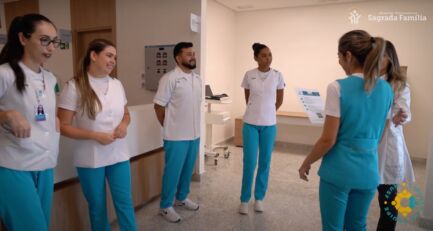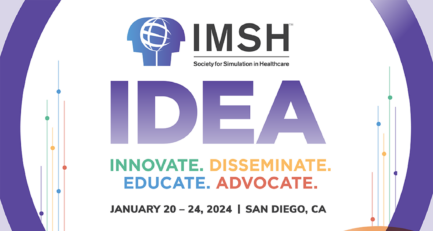The Boston Simulation Community will hold its monthly Research and Education meeting this evening, Tuesday, June 12th, from 5:30-7pm at the Center for Medical Simulation, 65 Landsdowne Street, Cambridge MA. Ann Mullen BSN, CCRN will be presenting, Does The Anxiety Of Seasoned Clinicians In The Simulation Environment Differ From That Of Novices? Ann’s important and interesting project grapples with an issue we have all faced as either instructors or participants in simulation programs.
 Ann Mullen is Program Manager at the Shipley Medical Simulation Center at Newton Wellesley Hospital. Her presentation of her work-in-progress will be an interactive session that asks us to provide feedback and ideas on her survey questions and research design.
Ann Mullen is Program Manager at the Shipley Medical Simulation Center at Newton Wellesley Hospital. Her presentation of her work-in-progress will be an interactive session that asks us to provide feedback and ideas on her survey questions and research design.
The Boston Simulation Community’s Research and Education meetings provide a friendly and informal venue for simulation educators and researchers to present work-in-progress, acquaint each other with relevant ideas from other disciplines and connect with others. These meetings are held on the 2nd Tuesday of most months. Please join us! If you would like to be added to the email list for these meetings contact Paul Montgomery at pmontgomery@harvardmedsim.org
Next meeting: July 10, 2012
Comined meeting with the CIMIT Boston Simulation Consortium
Ann Mullen BSN, CCRN, Work-In-Progress:
Does The Anxiety Of Seasoned Clinicians In The Simulation Environment Differ From That Of Novices?
Introduction
Simulation instructors have noticed that participants often express anxiety related to the simulation experience. Some say they are nervous about being videotaped, others say they do not like to be watched, and they are afraid of being embarrassed or feeling stupid. This anxiety seems to be more pronounced in senior clinicians; medical students and new nurses frequently volunteer for classes and do not display signs of anxiety. Simulation educators try to address this issue by providing information and reassurance, but theproblem often persists.
Simulation engages the learners in a realistic environment, and a certain amount of anxiety isbelieved to enhance the learning process. This heightened state of activation can aid in learning and retention. (DeMaria et al 2010). However, excessiveanxiety can make it difficult for learners to listen to instructions and learn new concepts. (Bong, Lightdale, Fredette, & Weinstock 2009). It is important for educators to be aware of the emotions experienced by the participants. This knowledge will prepare them to respond to the learners and meet their educational needs.
Theoretical background
Hans Selye examined the effect of stress in his landmark study (Selye 1936) and demonstrated that the physical response to injury included hormonal changes that were separate from the damage caused by the injury. He proposed the general adaptation theory to describe this response. He also used the term “distress” to describe stress caused by injury or illness, and noted that a stress response “eustress”, can also be induced by positive life events such as marriage or the birth of a child.
Subsequent studies have indicated that a certain level of emotional activation enhances learning and retention (DeMaria et al). However, the dose response curve is still uncertain; what is the amount of stress what will enhance learning? Too little stress will not engage the learners; too much may inhibit learning and induce defensive reactions.
The simulation environment poses no risk to patients, but it may be more stressful than clinical care for some people (Quilici et al., 2005). Simulation educators must be aware of the factors that may impede learning, and consider the impact of distress and eustress.
Review of the Literature
The literature search included keywords: anxiety, simulation, anxiety measurement, performance anxiety, and stress. Most of the results were related to the use of simulation to decrease anxiety of novice practitioners by preparing them for clinical practice. There were very few articles that addressed the issue of performance anxiety in seasoned clinicians.
Gore, Hunt, Parke and Raines (2011) studied the effect of a pre-clinical simulation experience. Junior baccalaureate nursing students were randomized to two groups. The experimental group participated in a four hour simulation class prior to their first clinical day; the control group had the simulation class after the first clinical experience. The experimental group reported lower levels of anxiety in their first patient encounter, compared to the control group.
Dr. Kathie Lasater (2007) examined the experience of nursing students using focus groups. Thisstudy explored the effects of simulation on the development of clinical judgment, and several important themes emerged. Despite the lack of patient risk, the simulation experience was stressful. Students described feeling anxious and stupid, yet the experience resulted in deeper learning.
Bong et al. (2010) compared the physiological response of learners in a simulation sessions and a traditional tutorial program. They demonstrated a significant increase in heart rate and salivary cortisol levels in the simulation subjects. They also noted that this response tended to diminish in clinicians who participated in more simulation sessions.
Quilici et al (2005) examined stress in the simulation environment during an Advanced Trauma Life Support (ATLS) test, compared to emergency department trauma care. Heart rate and blood pressure measurements were compared at several points: at baseline, during an ATLS test and while participating in emergency resuscitation in the emergency department. They found that heart rate and blood pressure were significantly higher during ATLS testing compared to emergency care. This finding supported the hypothesis that the ATLS exam was more stressful than clinical care of trauma patients.
Müller et al. (2009) studied performance and stress response of experienced critical carephysicians. The Anaesthetists Non-Technical Skills (ANTS) tool was used to assess performance, and stress was measured by salivary amylase and cortisol levels. They noted significant improvement in performance as well as significant stress. This study demonstrates the benefits and the potential difficulties of simulation.
Clapper (2010) described the emotional component of the learning process. He encouraged educators to be aware of the power of emotions to create an environment forincreased retention and deeper learning. He also cautioned that fear, intimidation and mistrust can hinder learning by triggering the fight-or-flight response. Blazeck (2011) noticed that senior faculty members were not comfortable with simulation, a phenomenon she describes as Simulation Anxiety Syndrome.
Several authors recommended further study on the subject of simulation anxiety. Simulation education is a relatively new specialty and the research in thisarea is limited; many of the papers rely on participant satisfaction, and lack objective data. The current literature focuses on the positive effects of simulation: improved technical skill, better team performance, reduced anxiety for novice clinicians. More study is needed in the area of anxiety, as it may interfere with learning, and cause clinicians to avoid simulation classes entirely.
Methodology
The goal of the study is to describe the anxiety experience of clinicians in a high fidelity simulation class. A mixed method descriptive study will be conducted using a survey method. The survey instrument will measure anxiety using theState-Trait Anxiety Inventory (STAI). The subjects will be asked to respond to open ended questions to obtain qualitative information.
The survey will be distributed to clinicians who are registered to attend a simulation class at the survey site. The sample will be limited to clinicians who are taking their first simulation class. The survey is optional and anonymous; surveys will be completed in a private area, and deposited in a locked container. The introduction to the survey informs subjects that their participation is entirely voluntary and anonymous. Completion of the survey will constitute consent for inclusion. All data will be reported in aggregate form; no identifiable data will be made public.
Research Question:
Does the anxiety of seasoned clinicians in the simulation environment differ from that of novices?
Data Collection:
In addition to the survey questions described above, age and gender information will be collected. Clinicians will be asked to provide additional data related to role, clinical experience, length of time in current role, and at this institution. The survey instrument is attached to this proposal as Appendix A.
Strengths/ Limitations
The STAI is a validated instrument which is frequently used to measure anxiety in the research setting. The additional questions constitute an adaptation of this tool and have not been tested. Other anticipated limitations in the study include the use of a single site for data collection.

